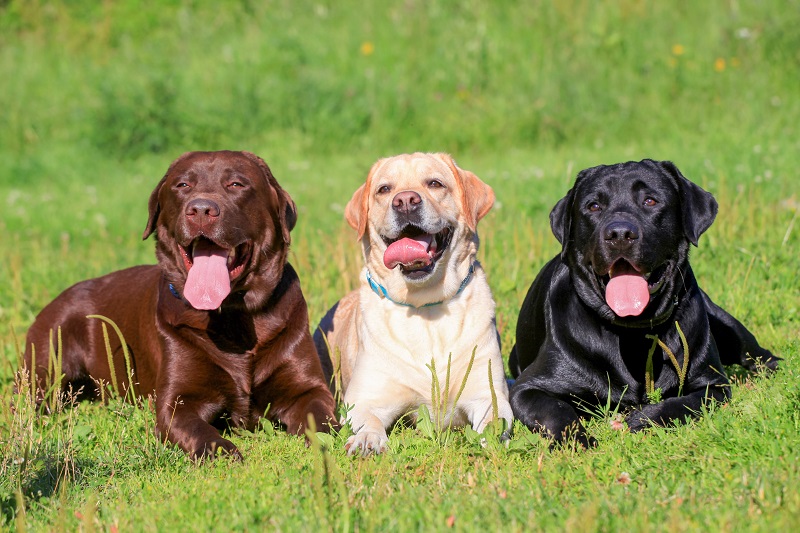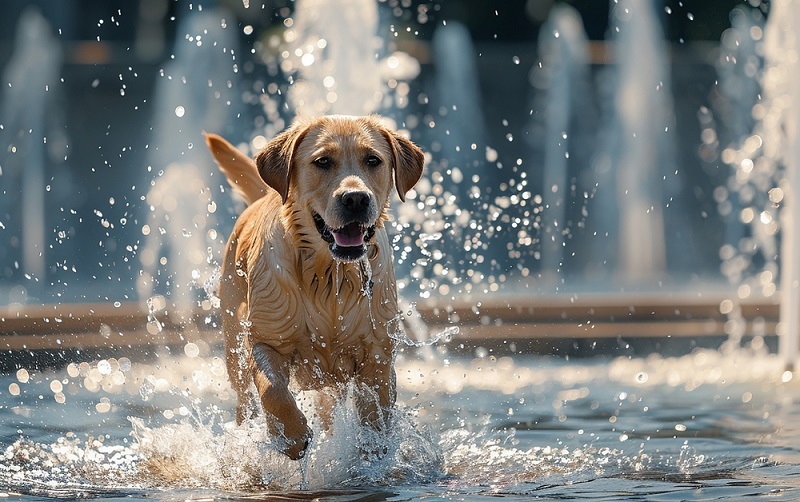In 2023, the American Kennel Club listed the Labrador Retriever as the second most popular breed in the United States as well as one of the top choices for service animals.1
There are lots of dog breeds out there, but labs seem to consistently make the leap from “pet” to “best friend” territory.
Whether you’re looking to welcome a Labrador Retriever puppy into your family or you’re just curious about what makes these beloved canines tick, we’ve got you covered.
A Little Lab History
The Labrador’s ancestors were from Newfoundland, Canada, and originally served as “sporting dogs” that helped hunters and fishermen retrieve game (this dog behavior is how they picked up the name “Retriever”).2
Later, British outdoorsmen took notice of the Labrador’s exceptional retrieving skills and further refined the breed during the 1800s, training them as hunting companions and crossing them with other sporting dogs. For close to a century, the lab served exclusively as a hunting dog.
Several industries then found ways to channel this Labrador Retriever training and their retrieving skills into new lines of work.
Today, many labs use their breadth of skills as:
- Seeing-eye dogs
- Bomb and narcotic detectors
- Search and rescue support
- Comfort and emotional support animals
Labradors have even demonstrated an ability to identify cancer and other illnesses by detecting certain telltale scents. It’s no wonder why the modern family adopted these intuitive, thoughtful animals as beloved household companions.
Why Are Labs So Popular? Temperament and Personality
From the 1970s on, the number of households with a Labrador Retriever skyrocketed.
The secret to the Labrador’s popularity? Their excellent temperament.
Labradors combine many agreeable traits into one adorable package3:
- Zest for life – Labradors are notoriously happy to do whatever, whether it’s cuddling up on the couch or bounding through the woods. They’ve got an enthusiastic spirit that is ready for anything.
- Friendliness – Labs aren’t especially territorial, and therefore co-exist easily with children, other pets, and their fellow service dogs.
- Devotion – Labradors come with an innate desire to please—they readily intuit what is expected of them.
- Stability – Life loves to throw curveballs, so a steady disposition is a key quality in an animal companion. Labs are cool just rolling with the punches.
- Warmth – Above all: Labrador Retrievers love to love! They are unsparing in their displays of affection and bond deeply with their human companions and trainers.
With personality traits like these, it’s easy to see how labs have won so many friends.
Keeping Labs Entertained: Exercise and Activity Needs
Labs are loaded with enthusiasm. They need plenty of exercise to give all that energy somewhere to go. In fact, the average Labrador Retriever requires around 2 hours of intentional exercise (with room for more) every day.4
If you plan to add a lab to your life, be ready to incorporate their considerable exercise needs into your schedule. (Even better: it can be a pleasant way to commit to your own fitness as well!)
Here are a few ways to give your Labrador Retriever a workout5:
- Walks – You can’t go wrong taking your lab for a stroll around the neighborhood—bonus points if you can find an off-leash environment, as freer movement will do more to support their overall dog health through cardio (and they’ll love the chance to chase a bird or two).
- Fetch – Centuries of Retriever dog training have made Labradors born fetchers. They’ll chase that ball until your arm is ready to fall off! Rotate locations to keep the game fresh and engaging for your pup.
- Games and toys – Labs are die-hard fans of doggy toys like tugging ropes, flirt poles, and chew toys. Spending some time playing tug-of-war with your lab is a fantastic opportunity to bond with them while scratching their instinctual itch.6
- Playdates – A playdate with another dog also counts as exercise! If both dogs are similar in size and age, they can each get a vigorous workout leaping and chasing one another. (You just may want to keep them outside—otherwise you might find your house… redecorated.)
Labs aren’t picky about how they get their zoomies out, so feel free to mix and match until you find what works best for your Labrador Retriever puppies.
The Happy Lab Diet: Nutrition and Fuel
As you might imagine, all that lovable energy requires fuel. In order to keep your lab healthy, you’ll want to understand their nutritional needs and provide them with a nourishing diet.
A few dog nutrition essentials to keep in mind7:
- Labs do well with a high protein, low carb diet—much like humans.
- Portion control is key. Labs’ innate enthusiasm can lead to overeating if unchecked.
- Puppies usually require four meals a day, while adult labs may need only two.
It’s also best to establish a feeding schedule and stick to it. Avoid sudden changes to your dog’s diet unless it’s absolutely necessary.
When it comes to what kind of food to feed your Lab, there’s no one-size-fits-all solution. The two most popular diets among Lab owners are the raw meat diet and the more traditional dry food (or kibble) diet. Like any diet, there are pros and cons to both.
Dry Food
Kibble has the advantage of being:
- Convenient – With dry food, dinner is ready in seconds. Just open a bag and pour it into a bowl. Many pet owners love the efficiency dry food offers. And because Labs are generally food-motivated, they love it, too.
- Storage friendly – You don’t need to refrigerate kibble, and it won’t spoil. It also doesn’t produce many unpleasant odors, especially if the bag is sealed between meals.
But kibble also comes with some drawbacks. Dry food often contains:
- Extra ingredients – Unless you purchase organic dry food, kibble may include bulking agents and filler that your dog can’t digest. This can lead to more frequent (and smellier) pooping, which some pet owners don’t appreciate.
- Excess grains – Grain is not a natural part of a dog’s diet, but it is the main ingredient in kibble. When digested, the body converts grains into sugars, which can promote diabetes and obesity.8
Raw Meat
When it comes to feeding your dog raw food, there are a few things you may want to consider:
- It’s natural – On the upside, raw meat does not come loaded with the filling agents present in kibble, which may help your pup digest their meals a bit easier. Dogs may also prefer the taste of meat to kibble or canned food.
That said, keep in mind that feeding your dog a raw diet takes work:
- It’s a bigger commitment – Keeping your lab on a raw diet requires more prep and lots of freezer space.
- It’s messy – While we all love to watch our favorite furry friend enjoy their dinner, if raw meat is on the menu, you might find the menu all over your floor.
In the end, it’s up to you what path to take on your Labrador’s diet. There’s no one “right” way to nourish your pup.
Keeping Labs Healthy: Common Health Issues
Their affectionate nature and obsession with exercise means labs are a pretty healthy dog breed overall (and good role models for us humans!).
That said, labs are prone to a few common ailments. Keep an eye out for Labrador Retriever health issues like9:
- Hip dysplasia – This occurs when the hip joint’s ball and socket don’t grow properly. Instead of working in sync, the ball and socket grind together and slowly damage the joint. The best way to prevent dysplasia and avoid dog surgery is to help your lab maintain a healthy weight.
- Ear infections – Yes, those big floppy ears are adorable. But they also accumulate dirt and moisture—bacteria’s best friends—very easily. Cleansers like Vetericyn Plus Antimicrobial Ear Rinse can help remove dirt and keep the ear canal clean, while Vetericyn Triple Action Ear Treatment can help relieve itching, clear infection-causing buildup, and restore a healthy ear environment.
- Skin problems – Do Labrador Retrievers shed? Labs have thick coats which can also invite bacteria to make themselves at home and cause hot spots (inflamed or infected skin sores). Vetericyn Plus Hot Spot Antimicrobial Hydrogel can help soothe hot spot irritation and other Labrador Retriever skin problems.
Loving Your Lab: Care Tips
Labs come with big hearts and sharp minds, so they need plenty of mental and social stimulation to stay happy. While giving your pet lots of loving attention is the best way to promote mental well-being, you should also explore other ways to help stay engaged.
Here are some ideas for activities you can do with your lab that will get their neurons firing:
- Go on a “sniffari” – An alternative to normal walks, a sniffari gives your dog a chance to lead with their nose. Using a longer leash, allow your lab to stop and sniff anything they want for as long as they want. You can also design “scavenger hunts” by hiding certain scents along your normal walking path.
- Turn on some “dog TV” – When you have to be away from home, try turning on some “dog TV” before you leave the house. There are several YouTube channels devoted to footage of squirrels, birds, and other lively outdoor scenery to encourage your dog to stay engaged instead of snoozing away the afternoon.
- Help them make friends – When you pass other dogs on the street, encourage your lab to say hello. You can also attend group classes or meet-ups with other dog lovers to give your pup a chance to play with friends. Be sure to supervise the interactions to make sure all canines (and their humans) feel comfortable.
Keep Your Lab Lively with Vetericyn
The Labrador Retriever is an easy pup to love, and anyone who has befriended one knows the boundless joy they can bring.
Another excellent way to help your Labrador Retriever thrive is to upgrade their diet with supplements like our ALL-IN 1 to support their overall health. Built around a foundation of grass-fed organ meat complex, ALL-IN 1 features a carefully calibrated formula of vitamins, minerals, and omegas to help fuel your lab’s adventures.
With Vetericyn, you can rest easy. Your pet’s health is in the right hands.
 Reviewed by C. Scott Van Winkle
Reviewed by C. Scott Van Winkle
Scott has been with Innovacyn for the past 11 years and has been working within the Burlingame portfolio of companies for the past 23 years. Scott brings a diverse background to Innovacyn. With an upbringing as the 5th generation on his families cattle ranch, Scott has a passion for animal health and the continuous improvement surrounding agricultural practices. Scott earned marketing and business management degrees from the University of Idaho and holds an Executive MBA from Pepperdine University.
Sources:
- American Kennel Club. Why Labs Are One of America’s Most Popular Dogs. https://www.akc.org/expert-advice/dog-breeds/why-Labradors-popular/
- The Canadian Encyclopedia. Labrador Retriever. https://www.thecanadianencyclopedia.ca/en/article/Labrador-retriever
- YourPurebredPuppy. Labrador Retrievers: What’s Good About ‘Em, What’s Bad About ‘Em. https://www.yourpurebredpuppy.com/reviews/Labradorretrievers.html
- Petplan. Labrador Retriever Facts & Advice. https://www.petplan.co.uk/pet-information/dog/breed/Labrador/
- The Labrador Site. Labrador Exercise: How to Keep Your Dog Fit. https://www.theLabradorsite.com/how-to-exercise-your-Labrador/
- K9 Basics. Why Do Dogs Like Playing Tug-of-War? https://k9basics.com/why-do-dogs-like-playing-tug-of-war/
- The Labrador Site. Labrador Feeding Demystified: A Comprehensive Expert Guide. https://www.theLabradorsite.com/how-to-feed-a-Labrador/
- WeFeedRaw. Unpacking the Controversy: Are Grains Bad for Dogs? https://www.wefeedraw.com/blog/the-great-grain-debate-do-dogs-need-grains
- Wag! 7 Common Health Problems in Labs. https://wagwalking.com/wellness/7-common-health-problems-in-labs

